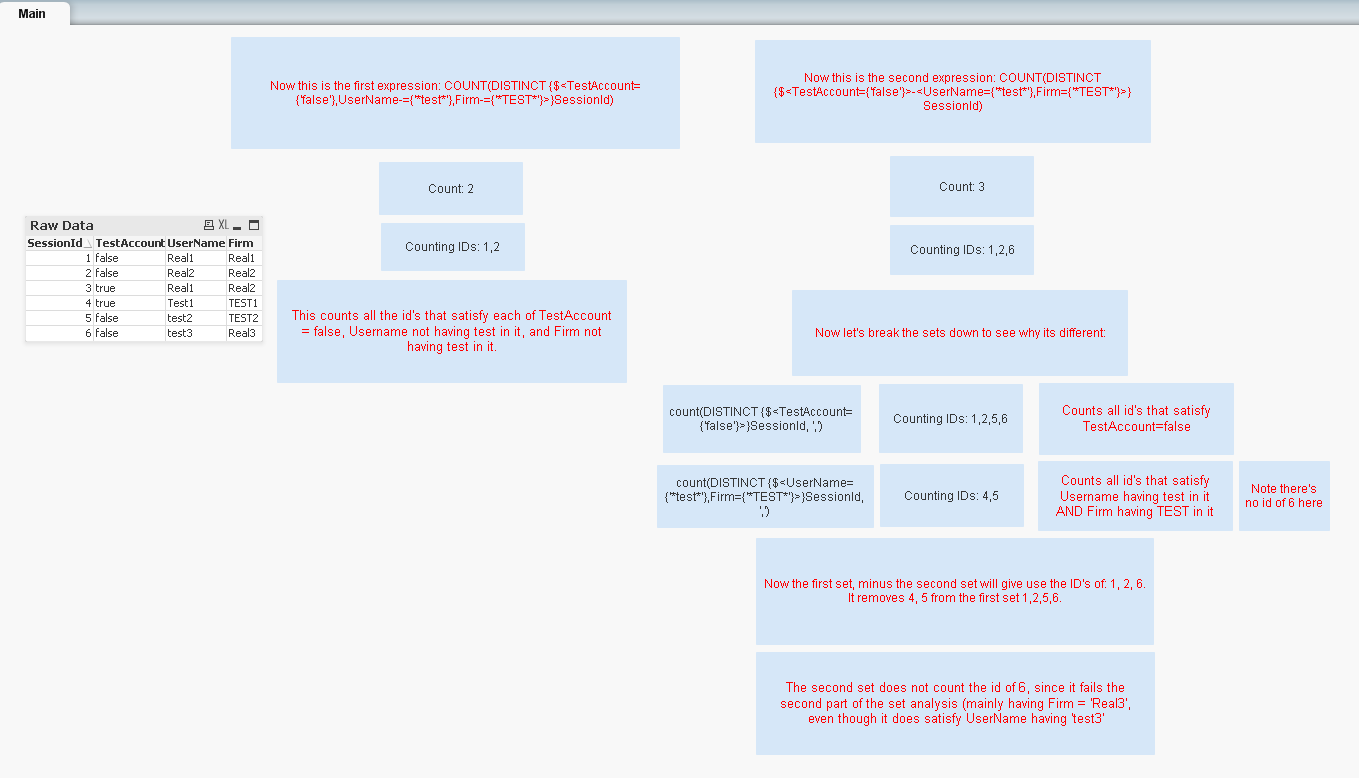Unlock a world of possibilities! Login now and discover the exclusive benefits awaiting you.
- Qlik Community
- :
- All Forums
- :
- QlikView App Dev
- :
- Set analysis best practice
- Subscribe to RSS Feed
- Mark Topic as New
- Mark Topic as Read
- Float this Topic for Current User
- Bookmark
- Subscribe
- Mute
- Printer Friendly Page
- Mark as New
- Bookmark
- Subscribe
- Mute
- Subscribe to RSS Feed
- Permalink
- Report Inappropriate Content
Set analysis best practice
What exactly is the difference between using the - sign as a set operator in a set analysis and using -= as a set identifier.
For example, what is the difference between these two expressions?
COUNT(DISTINCT {$<TestAccount={'false'},UserName-={'*test*'},Firm-={'*TEST*'}>}SessionId)
and
COUNT(DISTINCT {$<TestAccount={'false'}>-<UserName={'*test*'},Firm={'*TEST*'}>}SessionId)
Please don't copy and paste help text from the application as it is not hugely helpful. If anyone could explain it in plain english, that would be be great!
thanks very much
Alex
Accepted Solutions
- Mark as New
- Bookmark
- Subscribe
- Mute
- Subscribe to RSS Feed
- Permalink
- Report Inappropriate Content
Hi Alex,
You have to be careful interchanging the two. I have attached a difference in your example depending on the kind of data you might have. The counts can be different. Here is an image explaining what happens (also attached the qvw):

Hope this helps!
- Mark as New
- Bookmark
- Subscribe
- Mute
- Subscribe to RSS Feed
- Permalink
- Report Inappropriate Content
UserName-={'*test*'} - Select Count(Distinct SessionId) from table where TestAccount='false' and UserName Not Like '*test*'
TestAccount={'false'}>-<UserName={'*test*'}
Select Count(Distinct SessionId) from (
Select SessionId from table where TestAccount='false'
Minus
Select SessionId from table where UserName like '*test*' )
- Mark as New
- Bookmark
- Subscribe
- Mute
- Subscribe to RSS Feed
- Permalink
- Report Inappropriate Content
Both expressions will count distinct sessionIDs with TestAccount = False,
The first will exclude Usernames like TEST and Firm like TEST.
The second expression in also counting distinct TestAccounts that are false, but will include Username like Test and Frim like TEST.
- Mark as New
- Bookmark
- Subscribe
- Mute
- Subscribe to RSS Feed
- Permalink
- Report Inappropriate Content
Hi Alex,
I would take a look at this thread maybe, will give you a good overview of what the signage is doing
http://community.qlik.com/docs/DOC-4951
hope that helps
Joe
- Mark as New
- Bookmark
- Subscribe
- Mute
- Subscribe to RSS Feed
- Permalink
- Report Inappropriate Content
- Mark as New
- Bookmark
- Subscribe
- Mute
- Subscribe to RSS Feed
- Permalink
- Report Inappropriate Content
Hi Alex,
You have to be careful interchanging the two. I have attached a difference in your example depending on the kind of data you might have. The counts can be different. Here is an image explaining what happens (also attached the qvw):

Hope this helps!
- Mark as New
- Bookmark
- Subscribe
- Mute
- Subscribe to RSS Feed
- Permalink
- Report Inappropriate Content
Thanks Jeremiah. That was very clearly explained. Exactly what i was looking for!
I had overlooked the fact that the expression below meant AND and not OR
<UserName={'*test*'},Firm={'*TEST*'}>